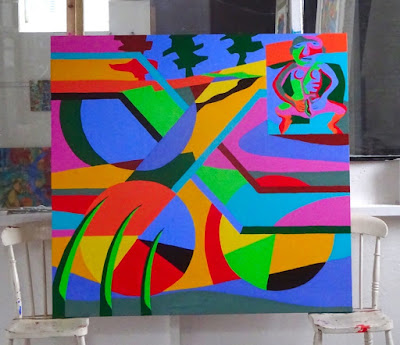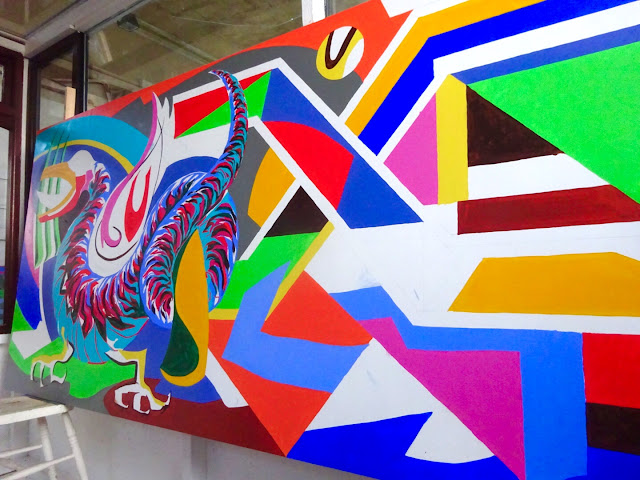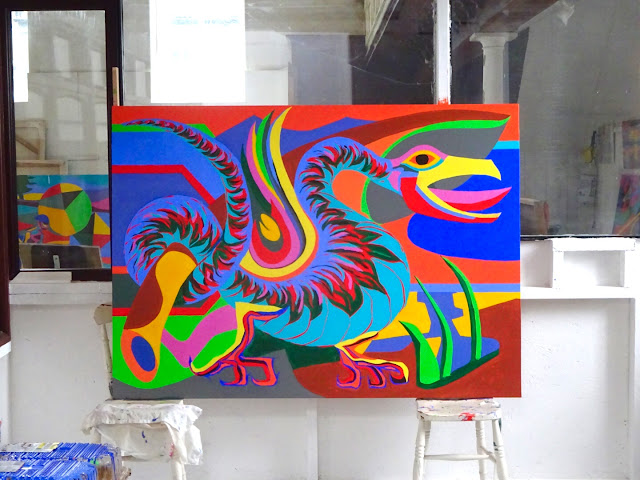Production started on the 28.1.21 after final confirmation that all seven recesses of the Walkway could be used for the planned design. Taking 36 days plus two varnish days, there were only two or three days between 28 January and 11 March when I was not actually painting. System 3 acrylic paint was used due to its good vibrancy, coverage, suitability for mural type application and particularly compatible exterior application. Colour range selected: Cadmium Yellow Hue, Cadmium Yellow Deep Hue, Cadmium Scarlet Hue, Process Magenta, Burnt Umber, Raw Umber, Burnt Sienna, Phthalo Turquoise, Leaf Green, Cobalt Blue Hue, Process Cyan, Ultramarine, Burnt Sienna and Titanium White. I also got a set of System 3 brushes, the chisel or sword type and these proved invaluable in being able to paint a tight edge and also into a point, between two other colours. This was particularly useful as all edges were hand painted (masking tape does not adhere to System 3) and with the numerous curved edges, hand painting was the expedient option.
Subject description for each panel can be found on the drawing post 13.1.21.
I decided to begin with panel 2 featuring one cyclist, Tom Norton Auto Palace (lettering) and the main interlocking frieze element. This panel had all the component elements and would undoubtedly serve as the test run in assessing scale and handleability of paint. Vibrancy was good and although I wanted all colours to remain as fully saturated, I found that the addition of white defined the surface particularly with the yellows. In fact only Scarlet Red, my mixed green and Cobalt Blue Hue were applied without white. Scarlet Red was notable this respect, Red being at least a semi transparent colour.
Panel 2 of 7 for Celf o Gwmpas Walkway project Llandrindod Wells. Video sketch of process over 6 days for viewing on mobile screen.
Next panel was number 4 featuring motifs based on the cheese making machines from Turner and Sons, Newtown (Museum). This panel took 7 days to complete. Each panel had at least one day to apply at least a second coat of each colour section.
On the interaction of colour. The composition is described through colour alone. Where one edge meets another describes the form and space between. There is no background (ever in a painting) and colour operates to complement the colour next to it, through a contrast, sometimes a grey (in this series mainly a grey made with process cyan, burnt umber and white) or another saturated hue. I want the intensity of the colour to operate in it's fullest sense; it's most intense manifestation and therefore the whole pictorial structure is made with colour and without white spaces. This is an important consideration in these works and when colour is applied throughout there comes a point in perception when it is operating in it's fullest sense without the need for white breathing spaces. As the painting is made all areas are applied with hue and the perceptive experience is of total colour.
Panel 4 of 7 for Celf o Gwmpas Walkway project Llandrindod Wells. Video sketch of process over 7 days for viewing on mobile screen.

Colour is applied only over one area buttressing against another so the white primed surface underneath will add to the luminosity of colour. In other words, forms do not overlap, otherwise the colour below would affect the colour on the surface. Although changes were made during process, in response to compositional developments through making, previous colour was wiped or repainted white to prepare.
Panel 3 of 7 for Celf o Gwmpas Walkway project Llandrindod Wells. Video sketch of process over 6 days for viewing on mobile screen.
Next panel, number 5, was the smallest section being close to a large blue fire escape door. Featuring the Llandrindod Wells Sheela-na-gig, the Cobalt Blue was excluded from the palette to part separate the painting from the door. This panel took 4 days to complete.
In making Hygeia Frieze, the perception is that everything is planned and drawn in a fixed place and to a certain extent with the drawings and studies this is true. However, as recorded in previous posts, studies and drawings in this case were only to establish motif and the idea of a composition. However, throughout the production, changes to design and colour were made in response to the greater area of the panels, materials (this paint system) and overall design. As in all my work, colour leads the way and is the structure, composition and meaning in the definition of form.
Panel 6 features Hygeia, Llandrindod Wells town emblem with the vertical elements referencing the work of Islwyn Watkins (Museum). Hygeia's bowl and serpent presented an opportunity for a semi circular form and swirling serpent form. As from the studies, yellow seemed to be the most potent colour for the serpents head so the rest of the swirling form would follow using the two yellows in the palette, Cadmium Yellow and Cadmium Yellow Deep. Forming the underside of the serpent the mixed Orange would provide the darker edge.
Panel 6 of 7 for Celf o Gwmpas Walkway project Llandrindod Wells. Video sketch of process over 6 days for viewing on mobile screen.
Panel 1 and 7 mark the entrance to the Walkway and feature the Griffin / Dragon. Initially referencing the Castel Collen Griffin (a double headed carved stone from the Roman fort) these bird like dragon forms greet the walkway visitor with open mouth and long tongue originated from the metal capitals on Exchange House in Spa Road. The way the metal Griffins are constructed with clenched foot, wing, neck and head, all support or touch the capital edge with protruding tongue and of course, paired on either side of the capital, inspired this Griffin / Dragon. The device of green foliage form behind the head seeks to contrast directional thrust of the head forms. Other natural forms in the frieze included tree and landscape elements in panel 3 and 5 and green foliage form in panel 6.
Panel 1 and 7 of 7 for Celf o Gwmpas Walkway project Llandrindod Wells. Video sketch of process over 11 days for viewing on mobile screen.
The final stage of production was varnishing with Daler Rowney Matt and Gloss vanish mixed to give a low lustre effect. The process had to be staggered over a week just prior to collection for the paint to cure as far as possible in the timescale.
 |
| Studio 20th March 2021 The panels were collected on 22nd March 2021 for installation at Llandrindod Wells |



























No comments:
Post a Comment